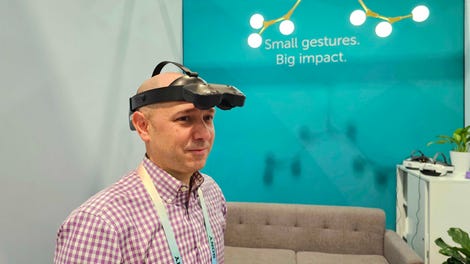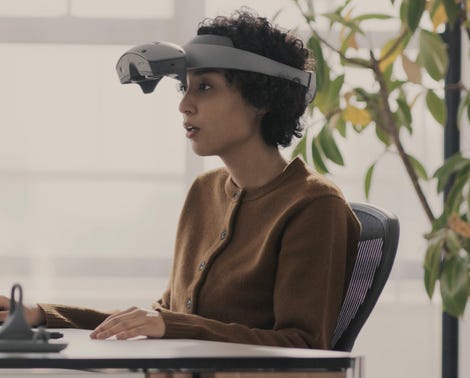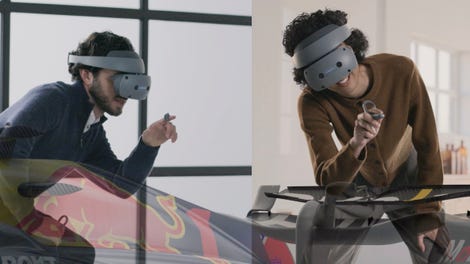The XR headset designed by Sony during the Siemens keynote at CES 2024. Sony/Siemens
The same day that Apple announced the release date of Vision Pro, Sony surprised CES 2024 by unveiling a product that no one expected at the world’s biggest high-tech event: a high-end XR (eXtended Reality) headset which rivals Apple’s Vision Pro in terms of capabilities and design.
This headset from Sony-Siemens should arrive in 2024
This headset from Sony-Siemens is expected to arrive in 2024 and will feature 4K OLED microdisplays, the new Qualcomm XR2+ Gen 2 chipset, handheld controllers and a design that echoes Sony’s PSVR2. It’s also attractive with sharp curves and a minimalist aesthetic.

I used the Lynx R1 helmet with its flip-up visor at the Ultraleap booth at CES 2024. Sabrina Ortiz/ZDNET
The XR headset was revealed during the CES 2024 keynote, presented by Siemens. Siemens CEO Roland Busch touted the benefits of the industrial metaverse and “digital twins” to accelerate the future of product development. He then welcomed Sony’s Yoshinori Matsumoto to unveil the product that would bring Siemens’ vision to life.
A very thoughtful design that Apple, Meta and other headset manufacturers could take inspiration from
Although the name Apple Vision Pro contains the word “pro”, it is aimed at the general public and professionals. This Sony-Siemens headset will not be used to watch 3D films, play immersive games or meditate in virtual reality on the top of a mountain. However, it could be used to create these types of apps and experiences for Vision Pro, Meta Quest, or other headsets.
It will also be used to prototype and design many products. It is aimed only at professionals, engineers and product designers, and it is designed as a content creation device that will streamline product development by creating 3D prototypes in virtual environments.
Still, the headset clearly features a very thoughtful design that Apple, Meta, and other headset makers could take inspiration from. I’ve tested a lot of different helmets and I’ve already tried the Vision Pro. There are two things that Apple’s device should have, in my opinion, to compete with Sony’s XR headset.
Two Sony headset features that Apple’s Vision Pro should have had
1. A flip-up visor
The first thing I noticed about the Sony headset is the fact that the face interface and screen flip up and down, so one can easily and quickly exit and return to mixed vision. This is one of the biggest challenges facing the Meta Quest 3 and other VR headsets.
The design of the Apple Vision Pro makes it clear that it will have the same problem, although Apple’s approach is to have high resolution through the screen so you can interact with your surroundings. With the Quest 3, third-party face straps like those from BoboVR have become very popular, especially among VR application developers who regularly switch between their computer and headset.
However, the Sony headset makes usage even more seamless since it was designed from the ground up with this feature in mind (as with headsets similar to the Lynx R1, which I also tried at CES). I wish all helmets were designed this way.

Flip-up facial interface of the Sony XR headset. Sony-Siemens
2. Portable controllers
Sony’s headset also offers a pair of wearable controllers in the form of a ring and a pointer that have a very futuristic appearance and practical application for working in virtual spaces. This brings us to one of my biggest questions about the effectiveness of the Vision Pro for professionals.
Although the Vision Pro’s interface is very intuitive, I wonder if the hand and eye tracking will be accurate and efficient enough to use for extended periods of time and manipulate 3D models (“digital twins”) ) in virtual spaces. As CNET’s Scott Stein wrote of Sony’s device, “the headset ring and pen/pointer controllers are its most unique features.”
At CES, I also tried out the Nolo VR Glass and its dedicated Nolo Air Ring accessory, which allowed me to see for myself how useful and natural a wearable ring can be in VR. I’m not suggesting that Apple replace its excellent eye or hand tracking system. But there are professional applications like 3D modeling and prototyping where support for add-on devices like Sony’s Ring and Pointer could boost Vision Pro’s effectiveness and make it more suitable for extended use in professional environments.

Sony XR headset portable controllers – ring and pointer. Sony-Siemens
To be clear, the Apple Vision Pro will do just fine without these two features. I am confident that the demand for this headset will be very strong and that consumers who try it will be blown away by the experience, especially the space videos and photos, as well as the panoramas in spatial computing. This is going to get a lot of people excited about VR, AR, and XR.
But where these two features are important, and where Sony got it right, is when it comes to particularly targeting the needs of professionals, developers and people who spend long hours with headphones on their heads and who need to be as efficient and useful in their schedule as possible. These are things Apple should consider for future versions of the Apple Vision Pro line.
To go further on the Sony XR headset
Source: “ZDNet.com”
